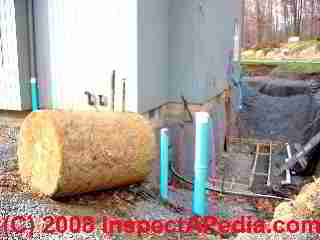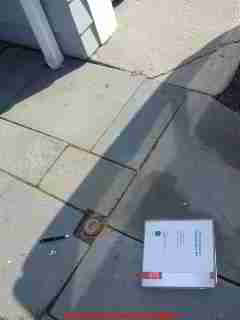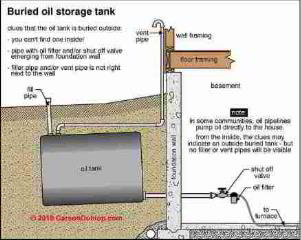 Underground Oil Storage Tank Life Expectancy
Underground Oil Storage Tank Life Expectancy
What determines the life of a buried oil tank & how long do they last?
- POST a QUESTION or COMMENT about typical oil storage tank life and factors that affect oil tank durability and leak risk
Buried oil tank life expectancy & life determining factors:
How long do buried oil tanks last: UST oil storage tank life expectancy. This article provides estimates for buried oil tanks and above ground oil storage tanks and we discuss the factors that impact the life expectancy of a buried tank. How long an oil storage tank can be expected to reliably contain its oil and not to leak depends on quite a few variables, all of which we describe here.
This article series discusses the typical life of oil storage tanks such as tanks used to store No. 2 home heating oil. Both above-ground oil storage tank life (AST life) and underground storage tank life (UST life) and the factors that determine the life of those tanks are explained.
InspectAPedia tolerates no conflicts of interest. We have no relationship with advertisers, products, or services discussed at this website.
- Daniel Friedman, Publisher/Editor/Author - See WHO ARE WE?
Buried Oil Tank Life Expectancy of Underground Oil Tanks - USTs
 This article discusses the typical life of USTs followed by a discussion of AST life.
This article discusses the typical life of USTs followed by a discussion of AST life.
Some things that can shorten the life of an oil tank can be avoided or corrected. The photo shows how a leak develops and appears in an indoor oil storage tank, forming a stalactite of oil and sludge hanging from the bottom of the tank.
[Click to enlarge any image]
Because an oil tank often rusts through from the inside out, the exterior of an oil tank may look fine but in fact it could be paper thin and easily punctured, even by a finger!
The life expectancy of oil tanks is helpful in planning for storage tank testing and storage tank replacement. This is a chapter of our "Heating Oil Underground & Above ground Oil Storage Tank Leaks, Testing, Problems & Solutions, Home Buyer's / Home Owner's Guide" which offers extensive free un-biased oil storage tank inspection and testing advice for property buyers and owners.
While we've found them lasting longer, a common life expectancy of buried oil tanks is 10-15 years.
At about 20 years, the risk of leaks from buried steel oil tanks becomes significant. Leaks can occur earlier if a tank was damaged at installation or was not properly piped.
Even if you think the tank is ok, young, and not leaking, buried oil tanks, should be tested for water in the tank bottom. Water should be pumped out since it corrodes the tank and leads to leaks. Oil tank leaks can also be due to damage at time of installation, improper installation, corrosive soils, or piping defects. If the tank is to remain in use, ask your fuel supplier about using an additive or other methods to help remove water.
Life Expectancy of Buried Oil Storage Tanks - Residential
In New England for a two year period [1984-5] among customers who had buried heating oil tanks (16% of total customers) surveyors found an average of 1.7 tank leaks per thousand customers.
They also found 2.5 fuel line leaks per 1000 customers.[4] This finding that twice as many heating oil system leaks occurred in the fuel piping is consistent with the Maryland study reported below.
A 1986 Maryland study found a 40% leak rate in petroleum product storage tanks (oil, gas, kerosene, waste oil) of which oil piping caused 82% of all leaks, and location (urban vs rural) and soil conditions were important factors in leak occurrence.[3]
We do not have similar data for buried gas tanks in residential application.
Also see OIL TANK LEAKS & SMELLS. Sketch of a buried heating oil tank installation is provided courtesy of Carson Dunlop Associates.
Underground Outdoor Oil Storage Tanks (USTs) and Life Expectancy Factors

- Exposure of the oil tank filler to water entry or surface runoff (as shown in the photograph): some oil tank installers or homeowners insist on installing the tank filler
flush with or even below ground level, perhaps for aesthetic reasons.
This detail increases the risk of snow melt or surface runoff entering the oil storage tank, particularly if the filler cap is left off or if its o-ring or gasket seal is not perfect. - Wrong tank type for buried use: smaller oil tanks which have been buried, such as a 250g or 275g tank, especially if more than 10 years old, are suspect: we have
not ever found one of these that was labeled as approved for outdoor below-ground use.
If you have a buried oil tank in this size range further investigation is warranted. - Mechanical damage to the tank during installation, such as scraping its protective coating (if there was one), or omission of
any protective coating on the buried tank.
Damage might occur for example, by scraping the tank with equipment used to move it, or by setting the tank into a hole atop a rock or other debris. Fiberglass or plastic tanks may be more vulnerable to serious mechanical damage during installation. - Mechanical damage to buried oil tanks & tank piping due to vehicle traffic passing over or near the tank, causing movement, flexing soils or flexing tank and piping
- Damage to oil storage tank when fill & vent piping are struck by vehicles outside, causing bends or cracks where those pipes connect to the top of the oil storage tank (this can happen to both buried and above ground oil tanks)
- Corrosive soils - soil corrosivity may be a significant factor in buried steel oil tank life in areas of soils with a high
corrosivity index.
Plastic or fiberglass tanks are less likely to be affected by soil corrosivity. But oil tank piping and piping connections will be impacted by soil corrosion and are a principal source of leaks. Burying copper or brass oil tank piping & fittings touching or in close proximity to other buried pipes such as a galvanized iron water pipe can also cause corrosion.[3]
See GALVANIC SCALE & METAL CORROSION - Conductive soils - clay soils that are more conductive than sandy soils increase the exposure of the buried oil storage tank to electrical currents, especially in urban areas or where there are electrical grounding or wiring faults.
Electrical current exposure can increase oil tank corrosion and can exacerbate galvanic corrosion already going on. [3] - Amount of ground water in soil: wet soils increase the risk of corrosion on buried steel tanks and increase the risk of leaks into a damaged (or poorly plumbed) tank for both steel and plastic/fiberglass oil storage tanks.
- Defective oil storage tank welds
Question:
(Dec 10, 2014) Anonymous said:
some say that a 2mm tank is not good. but if you have a 2.5mm tank is good. but you need a inspection to get oil delivered. My tank is only 10 years old and it like new in basement.They are telling us that we have to change.What are the by-law on this situation.
Reply:
Anon
If there are "by laws" - meaning regulations that apply to your situation they will be defined by your state, province, county, or town. Start with your state DEP or DEC or your local building department when asking about regulations.
Or in More Reading (links just above) see the article series beginning at OIL TANK LEAK & ABANDONMENT REGULATIONS for details.
I am not aware of law or regulation that describes what you report.
Question:
(May 14, 2015) David said:
I have an existing enclosure above ground that has the following volume space for a residential fuel oil storage tank. The volume dimensions are 32” high, 96” long and 72” wide. I prefer the tank to be lined with a non-rusting material to prevent rusting from the inside out. I need a single fuel oil tank that will fit within the above dimensions. The fuel oil filler and vent pipe fittings need to be placed on the top right hand section within (3” to 6”) in from the edge along the (96”) length dimension and no more than (42”) from the right hand corner.
The tank will need to be adjusted in height to allow for the standard filler and vent pipe installation at the top. The tank will also need to accommodate the standard fuel oil fitting for the furnace fuel line feed at the bottom.
The fuel line feed for the furnace should be located anywhere along the bottom edge of the (72”) length adjacent to the corner of the fuel filler and vent pipe fittings. The tank dimensions only need to clear the enclosure dimensions by (2”) for maneuverability for putting the tank in place. I estimate the tank volume to be approximately 1370 cu. Ft. This amount of volume should be sufficient for one season of heating here in New Hampshire. I will hire a licensed well known fuel oil company for the tank installation.
I would be interested in estimated cost and availability. I would appreciate your feedback on this project. I can send a jpeg file for further clarification if required.
Regards,
David Provencher
dproven1@myfairpoint.net
Reply:
David it would make most sense to get cost and availability data from your local storage tank suppliers. We do not sell any product nor service. Doing so would be a conflict of interest with providing unbiased reader information.
Question:
(May 25, 2015) Larry said:
I have a 275 gallon heating oil tank in the basement that just started to drip very slightly from the bottom of the tank its self in the wall of the tank. Is there a repair kit that I can get to put over that spot till I can use the oil up that is in the tank (yup its full )then I want to convert to gas and get rid of the tank
Reply:
Yes there are some clamp on or epoxy repair kits. Watch out about screwing in conventional tank washers and bolts at leak points as you can create a much bigger faster leak.
...
Continue reading at OIL TANK LIFE EXTENSION or select a topic from the closely-related articles below, or see the complete ARTICLE INDEX.
Or see this
Article Series
Suggested citation for this web page
BURIED OIL TANK LIFE EXPECTANCY at InspectApedia.com - online encyclopedia of building & environmental inspection, testing, diagnosis, repair, & problem prevention advice.
Or see this
INDEX to RELATED ARTICLES: ARTICLE INDEX to HEATING OIL, OIL BURNERS, OIL FIRED HEATERS, OIL TANKS
Or use the SEARCH BOX found below to Ask a Question or Search InspectApedia
Ask a Question or Search InspectApedia
Try the search box just below, or if you prefer, post a question or comment in the Comments box below and we will respond promptly.
Search the InspectApedia website
Note: appearance of your Comment below may be delayed: if your comment contains an image, photograph, web link, or text that looks to the software as if it might be a web link, your posting will appear after it has been approved by a moderator. Apologies for the delay.
Only one image can be added per comment but you can post as many comments, and therefore images, as you like.
You will not receive a notification when a response to your question has been posted.
Please bookmark this page to make it easy for you to check back for our response.
IF above you see "Comment Form is loading comments..." then COMMENT BOX - countable.ca / bawkbox.com IS NOT WORKING.
In any case you are welcome to send an email directly to us at InspectApedia.com at editor@inspectApedia.com
We'll reply to you directly. Please help us help you by noting, in your email, the URL of the InspectApedia page where you wanted to comment.
Citations & References
In addition to any citations in the article above, a full list is available on request.
- The rate or frequency of oil tank leaks or oil storage tank failures, focused on underground storage tanks or USTs, is discussed in detail at TANK FAILURE RATES Oil Tank Failure Data - Oil Tank Failure Rates - Oil Tank Leak Probability as a Function of Tank Age, Location, Condition, Soil Conditions and Other Factors. TANK REGULATIONS outlines who, when, and how oil leaks and spills must be reported to environmental authorities.
- Thanks to Robert Frank for email discussion about oil storage tank life, 1/21/2010
- [1] Fuel Storage] Tank Corrosion Study, U.S. EPA report on gasoline and oil tank corrosion, James H. Pim, P.E., John M. Searing, Suffolk County DOHS, 15 Horseblock Place, Farmingville Long Island, NY 11728, November 1988, for the Office of Underground Storage Tanks, U.S. EPA. ATTN: David O'Brien. The report presents a study of 500 underground storage tanks spanning 24 February 1987 and September 1 1988 and summarizes earlier reports on this same study. Tank sizes ranged from 175 gallons to 50,000 gallons, and oil tank ages ranged from two years to 70 years old. All 500 oil storage tanks were constructed of welded steel, and 12 other tanks that were other than plain steel were also examined. Summary [with minor edits for clarity by DJF]
- [3] "A Case Study of a Large Scale Precision [oil or fuel] Tank Testing Program", Diane H. Heck, Tetra Tech Richardson, Newark, Delaware, web search 4/27/12, original source: http://info.ngwa.org/GWOL/pdf/870143411.PDF, copy on file as /heating/OIl Tanks UST/Tank_Test_Heck_870143411.pdf
- [4] Fuel Oil and Oil Heat Magazine, August 1985 p.18. Fuel Oil & Oil Heating Magazine, 3621 Hill Rd., Parsippany, NJ 07054, 973-331-9545
- [5] Standards of the National Board of Fire Underwriters, as referenced by "Domestic and Commercial Oil Burners,", Charles H. Burkhardt, 1961, 3rd Ed., McGraw Hill Book Company, p. 172
- [6] NFPA - the National Fire Protection Association can be found online at www.nfpa.org
- [7] "The Interim Prohibition Guidance for Design and Installation of Underground Oil Storage Tanks", U.S. EPA, EPA/530-SW-85203, Office of Underground Storage Tanks, Washington D.C.
- [9] US EPA "How do you Properly Close a UST?" is summarized at epa.gov/OUST/fsprevnt.htm These details for temporary and permanent closing of underground oil storage tanks are provided by the US EPA as well.
- [10] "How do you choose the right tank testing method?", Cynthia Johnson, Fuel Oil & Oil Heat Magazine, November 1995
- [11] National Association of Oil Heat Service Managers, PO Box 380, Elmwood Park, NJ 07407
- [12] "Homeowners Guide to Fuel Storage," Agway Energy Products, Verbank, NY, November 1990
- [13] "Causes of Underground Corrosion", Harco Corporation, Paper HC-36, Median OH
- Our recommended books about building & mechanical systems design, inspection, problem diagnosis, and repair, and about indoor environment and IAQ testing, diagnosis, and cleanup are at the InspectAPedia Bookstore. Also see our Book Reviews - InspectAPedia.
- In addition to citations & references found in this article, see the research citations given at the end of the related articles found at our suggested
CONTINUE READING or RECOMMENDED ARTICLES.
- Carson, Dunlop & Associates Ltd., 120 Carlton Street Suite 407, Toronto ON M5A 4K2. Tel: (416) 964-9415 1-800-268-7070 Email: info@carsondunlop.com. Alan Carson is a past president of ASHI, the American Society of Home Inspectors.
Thanks to Alan Carson and Bob Dunlop, for permission for InspectAPedia to use text excerpts from The HOME REFERENCE BOOK - the Encyclopedia of Homes and to use illustrations from The ILLUSTRATED HOME .
Carson Dunlop Associates provides extensive home inspection education and report writing material. In gratitude we provide links to tsome Carson Dunlop Associates products and services.


